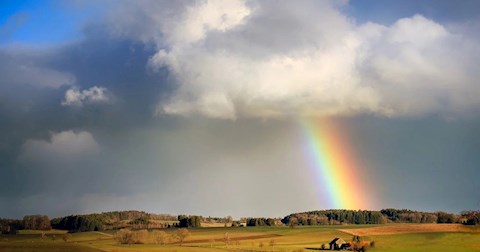Anonymous
Mar 26, 2020
Where do rainbows come from?
Where do rainbows come from? William Wordsworth, an English poet who published his first sonnet in 1787, wrote: My heart leaps up when I behold A rainbow in the sky . . . Something about seeing a rainbow gives us a shivery feeling. The bands of color, dipping down from the sky, are so beautiful and rare. People once thought rainbows were signs from the gods. It’s not surprising. A rainbow appears in the sky, seemingly out of nowhere. Then, just as mysteriously, it vanishes.
1 view

1 view
1 answer
Sort By
Anonymous
Mar 26, 2020
Today, we know something about how rainbows are made, but that should not make us appreciate them any less. Scientists who unravel rainbow mysteries use math. They say that even the math that explains a rainbow is special and lovely (although it’s also very complicated).
The colors of a regular rainbow always come in the same order: first red, then orange, yellow, green, blue, indigo, and violet. Red is the brightest band of color, running along the top of the bow. Then come the others, each paler than the last. Violet, the inner band, is dimmest and hardest to see of all.
What are rainbows made from? The recipe is simple: droplets of water in the air, light, and someone to look up at just the right moment.
It’s not enough, however, for the Sun to come out during a shower. A rainbow is a kind of trick of light, and the conditions must be just right for us to see one. Sunlight must be streaming from behind us, so the Sun must be low on the horizon. And in front of us, of course, there must be a curtain of falling raindrops.
How does it work? A beam of sunlight, making its long journey from space, plunges into the heart of a raindrop. When a ray of sunlight pierces the drop, it begins to bend. That’s because the light is passing into water, which is much denser (its molecules more closely packed) than thin air.
White light is really a blend of hidden colors—red, orange, yellow, green, blue, indigo, violet (think Roy G. Biv). And as a light beam enters a drop, each color, or wavelength, bends (refracts) a little more or less, like sunlight passing through a glass prism. The result? The white sunbeam splits apart into beautiful rays of color, each going off on its own direction inside the drop.
Inside the raindrop, the colored rays collide with the mirrorlike raindrop wall, bend again, and shoot back out of the drop. Making their escape, the colored rays bend again as they move from denser water into open air. The sunlight had originally come from behind you. Now the altered light, in its true colors, is shooting back at you.
While all raindrops in the sky refract sunlight, we’re only able to see the light coming from drops at a certain viewing angle. From this “rainbow band” of drops, our eyes receive different colors from drops in different positions in the sky.
Since red and orange wavelengths are bent the most, we see these colors courtesy of higher drops. Blue and violet are less sharply bent, so we get these colors from lower drops. Yellow and green are provided by the drops in the middle of the band. And you see an arc of colors, stretching across the sky.
Because they are tricks of light, rainbows aren’t “things” in the sky, like birds or clouds. Each person present sees a different rainbow (or, if lucky, double rainbow) made from the light rays streaming in from behind and the raindrops in front. The rainbow you see is yours alone.
Fast Fact:
You don’t always need raindrops to make rainbows. Light can be refracted by fog or by a spray of water from a garden hose.
0